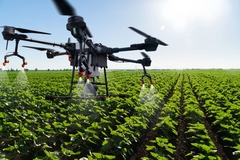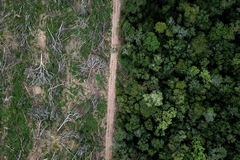Indian algae-based food pioneers probe the protein capabilities of coastal crops
31 Mar 2021 --- In a new report, the Good Food Institute (GFI) highlights opportunities to utilize India’s 8,100 km long coastline for seaweed cultivation, which in turn could provide the foundation for the local algal protein industry.
As an alternative to large-scale industrial animal agriculture, “smart proteins” hold enormous potential for feeding the nation’s ballooning population. The country has the unique advantage of the presence of companies that are already producing food-grade microalgae, notes GFI.
This coastal crop is being explored by the nation’s sustainable food pioneers as a way out of the environmental degradation of local land and freshwater sources.
“There are already start-ups in India that are working towards creating ingredients from microalgae that can go into alternative meat, and dairy products,” Rama Tentu, GFI India’s sci-tech research fellow, tells FoodIngredientsFirst.

“Additionally, government-funded open access research and policy stimulus would help drive further innovation and entrepreneurship in food applications of algal protein,” adds Satvika Mahajan, policy specialist at GFI India.
“The government’s recent efforts to promote seaweed cultivation is a step in the right direction, and a similar push for microalgae will have huge implications in its usage by the food industry.”
 The Indian government and industry have already pledged ₹6,400,000,000 (US$87 million) to develop the seaweed economy in the country.Securing national health priorities
The Indian government and industry have already pledged ₹6,400,000,000 (US$87 million) to develop the seaweed economy in the country.Securing national health priorities
On the global market, microalgae’s applications have expanded into baked goods, ice creams, mayonnaises and egg replacements. In India, Tentu notes there is potential to fortify local delicacies to help promote health on national scale.
“Spirulina-infused groundnut Chikki – a traditional Indian sweet generally made from nuts and jaggery, or cane sugar – has been developed by the Mysuru-based Central Food Technological Research Institute (CFTRI) and was provided to migrant workers to boost the immunity of the people during this time of the pandemic.”
Industry is always on the hunt for vegan sources with added value. The “food as medicine trend” has become a worldwide trend during the COVID-19 pandemic, putting Innova Market Insights’ Top Ten Trends for 2021, “Nutrition Hacking” and “Immune Health” at the top of mind for consumers.
Capitalizing on a coastal crop
GFI’s report, entitled Technological Review of Algae-based Proteins, is a result of a strategic assessment of the algal value chain from strain selection to protein extraction, with the aim to inform stakeholders in the Indian market about pivotal and potentially lucrative interventions required to develop the algal protein sector.
The Indian government and industry have already pledged INR ₹6,400,000,000 (US$87 million) to develop the seaweed economy in the country, while the United Nations and World Wildlife Fund have also identified this as a major area of growth.
Funds from the fisheries initiative are to be spent over the next five years as subsidy support.
“The Finance Minister in her Union Budget 2020 speech announced that the cultivation of seaweed and microalgae will be promoted by the setting up of extension services through 3,477 sagar mitras and 500 fish farmer producer organizations (FPOs),” says Tentu.
With the help of action groups and FPOs, the Indian government aims to boost local sales of seaweed, spirulina and other algae. “Companies like AquaAgri and Sea6Energy closely work with local communities to create a pipeline of seaweed produce for developing end market products,” notes Mahajan.
“Research institutes like Central Salt And Marine Chemicals Research Institute (CSMCRI) and Central Marine Fisheries Research Institute (CMFRI) have been closely working with farmers to implement efficient farming practices in local communities.”
 In Western markets, major retailers have backed the rollout of seaweed-based meat analogs, which are increasingly popular. (Source: The Dutch Weed Burger)Tapping into India’s microalgae market
In Western markets, major retailers have backed the rollout of seaweed-based meat analogs, which are increasingly popular. (Source: The Dutch Weed Burger)Tapping into India’s microalgae market
For new microalgae businesses, a critical opportunity in the Indian market is the development of downstream processing facilities which can create ingredients from freshly harvested microalgae and seaweed, Tentu explains.
“We would urge companies to look at the opportunities database which lists down opportunities for every stakeholder in the Indian ecosystem,” she adds.
“Another white space to target would be creating an end market application like a seaweed-based fish or shrimp. As the production of microalgae and seaweed scales in India, creating alternative meat, egg, dairy, and seafood from algae will become logistically and economically feasible in the coming future.”
In Western markets, major retailers have backed the rollout of seaweed-based meat analogs, which are increasingly popular. Last month, The Dutch Weed Burger unveiled burger patties made from protein-rich, salty soy chips and enriched with Royal Kombu.
Formulating with algal ingredients
Two Chlorella vulgaris microalgae powders, manufactured by the Portuguese provider Allmicroalgae, were recently approved as food ingredients and food supplements by the European Food Safety Authority (EFSA).
The variants White and Yellow Chlorella vulgaris are noted for their neutral sensory profile and lighter color compared to conventional, intensely green-coloured microalgae.
Last December, Cargill has unveiled its first seaweed powder offering within the WavePure ADG line – WavePure ADG 8250. From an organoleptic perspective, this “familiar and versatile” marine ingredient was developed to accentuate smooth and creamy textures in dairy, while offering gelling and thickening properties.
In other developments, Kemin Industries has received approvals in the EU and Brazil, allowing its algae-sourced beta-glucan ingredient BetaVia Complete to be placed on both markets. The “year-round immune support” ingredient is manufactured through a patented process using a proprietary strain of algae, Euglena gracilis ATCC PTA-123017.
By Benjamin Ferrer













